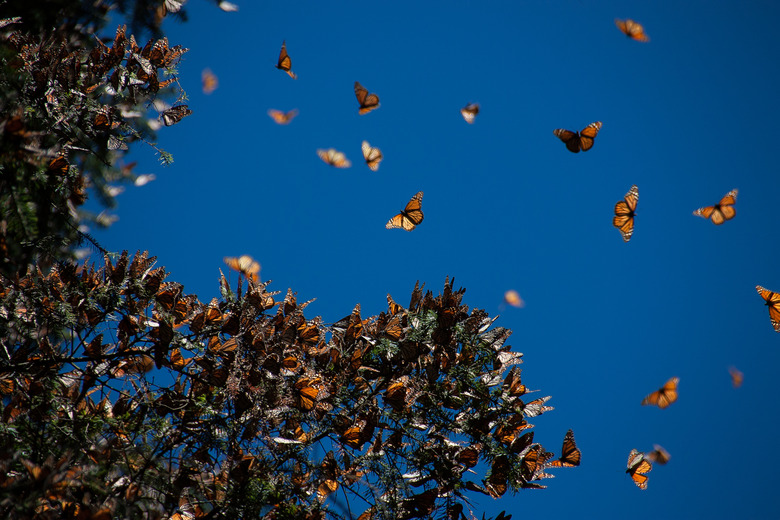Monarchs Migrate 3,000 Miles Each Year — And They Need Your Help
If you live in Canada or the United States, there's a good chance you've seen a monarch butterfly. Maybe you saw some fluttering around your small mountain town, or caught a glimpse of their orange wings in an otherwise concrete-grey big city. Maybe you even did a little science experiment in your home, where you watched the evolution of egg to caterpillar to chrysalis to monarch.
What you may not know is that millions of those butterflies that spend who spend the summers along the eastern coast of Canada and the U.S. congregate in the same place for winter. Doesn't matter if they lived near your house in Toronto or called Tennessee home – more than half of Eastern North American monarchs find their way back to a small plot of land in Mexico now known as the Monarch Butterfly Biosphere Reserve, or El Rosario butterfly sanctuary.
For decades, tourists and locals alike have flocked to the area to witness the incredible sight of millions of monarchs in one place. Visitors said that in some areas, swarms of gently flapping monarch wings would turn green landscapes to orange.
But now, it's under attack. Some local officials want to start using the land near the sanctuary for logging. And while environmental activists are fighting back, it's an uphill journey to advocate for the lowly monarch as developers try to cash in on valuable natural resources.
A Mysterious Journey
A Mysterious Journey
Those natural resources are increasingly rare on a planet where humans have to accommodate for growing populations amid a climate crisis. But the monarch journeys to Mexico also have an air of rarity and mystery to it.
The trip would be extraordinary by any standards. Imagine having to make it to a sanctuary in Mexico using only two small wings. You didn't have Google Maps, you didn't have a GPS system, and you didn't have a gas station where you could fuel up and ask for directions. All you had was the knowledge that you had to be at a certain spot in Mexico by a certain date.
Except that's the thing – no one knows where that knowledge comes from. It's not memory. From the time when butterflies leave Mexico in the spring to when they go back there in the fall, four generations of monarchs have been birthed. That means that a monarch who left El Rosario is the great-grandparent of a butterfly who arrives there. That great-grandparent didn't leave behind a map about the journey its offspring would have to take. But somehow, its offspring knows. And it will somehow pass that knowledge down to its own great-grandchild.
Similar mysterious migrations happen with other animals, too. Swallow birds used to return to San Juan Capistrano in California every year. Recent building in the area made numbers drop, but residents took measures like releasing ladybugs and mimicking their mating call on speakers to draw them back, which seemed to at least somewhat work. Eels are another strange migratory tale. When they're ready to leave Earth, European eels make a journey to the Sargasso Sea to spawn once and then die.
How Does That Even Work!?
How Does That Even Work!?
Scientists aren't sure, exactly. All they do know about monarch migration is that their Mexican home should be protected. Several environmental activists are working towards that goal, including two named Homero Gomez Gonzalez and Raul Hernandez Romero.
Gonzalez used to be a logger, but transformed into a conservationist who managed the sanctuary. Romero was one of the guides that took eager tourists on visits to the reserve. Neither man wanted to stop business and development in that area; instead, they wanted that business to be ecotourism rather than the illegal logging of the area's protected woods. Tragically, both met untimely and suspicious deaths at the beginning of this year.
The situation is dire, and it's tough to feel like you can help if you're not near the reserve in Mexico. But there might be something you can do to help monarchs right in your own backyard (literally), or the garden at your school.
By planting some milkweed and keeping an eye out for monarch eggs, you could help give butterflies a food source that's threatened, help nurture their growth in an increasingly hostile environment and send them on their way hoping that more activists as brave as Gonzalez and Romero continue to fight for the monarchs to have a home.
Cite This Article
MLA
Dragani, Rachelle. "Monarchs Migrate 3,000 Miles Each Year — And They Need Your Help" sciencing.com, https://www.sciencing.com/butterfly-activist-conservation-story-13724847/. 19 February 2020.
APA
Dragani, Rachelle. (2020, February 19). Monarchs Migrate 3,000 Miles Each Year — And They Need Your Help. sciencing.com. Retrieved from https://www.sciencing.com/butterfly-activist-conservation-story-13724847/
Chicago
Dragani, Rachelle. Monarchs Migrate 3,000 Miles Each Year — And They Need Your Help last modified August 30, 2022. https://www.sciencing.com/butterfly-activist-conservation-story-13724847/
